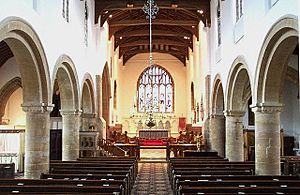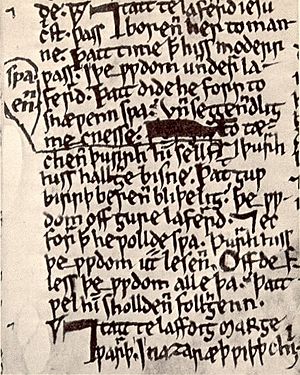Ormulum facts for kids
The Ormulum (also called Orrmulum) is a very old book from the twelfth-century (the 1100s). It was written by a priest named Orm who was an Augustinian canon (a type of priest). The book has almost 19,000 lines of early Middle English poetry. It explains parts of the Bible.
Orm had a special way of spelling words. This unique spelling helps us understand how English was pronounced long ago, especially after the Norman conquest of England when the language was changing a lot. Because of this, the Ormulum is very important for people who study how languages change over time.
The book starts with a short introduction and a dedication. Then, it has many sermons (called homilies) that explain Bible stories used in church services throughout the liturgical year (the church year). Orm wanted priests to use his book to help people understand the Bible readings. If you read it all at once, it can be a bit boring and repetitive.
Only one copy of the Ormulum still exists today. It is kept in the Bodleian Library in Oxford. This copy only has about a fifth of the material Orm planned to write.
Orm created a very unique spelling system. Scholars today think he did this to help priests speak English correctly, especially the vowel sounds. Many local priests at the time might have spoken Anglo-Norman French more often than English. Orm also used a very strict rhythm (called a metre) in his poetry. This helped readers know which parts of words to stress. By looking at Orm's spelling and his strict rhythm, experts can figure out how Middle English was spoken when Orm wrote his book.
Contents
Who Wrote the Ormulum?
It's unusual for old books from this time to have an author's name or a title. But the Ormulum is different! Orm clearly named himself and his book.
At the end of his dedication, Orm wrote:
| Early Middle English | Modern English |
|---|---|
| Icc was þær þær i crisstnedd was | Where I was christened, I was |
| Orrmin bi name nemmnedd | named Ormin by name |
Then, at the beginning of the book, he named himself again with a slightly different spelling and gave the book its title:
| Early Middle English | Modern English |
|---|---|
| Þiss boc iss nemmnedd Orrmulum | This book is named Ormulum, |
| forrþi þatt Orrm itt wrohhte | for Orm created it |
The name "Orm" comes from an old Norse word meaning worm, serpent, or dragon. Adding "myn" (for "man") made it "Ormin". This name was common in the Danelaw area of England, where many people had Viking (Norse) backgrounds. Orm probably chose between "Orm" and "Ormin" to fit the rhythm of his poetry.
The title "Ormulum" is like the Latin word speculum, which means "mirror". Many medieval books had "mirror" in their titles, meaning they reflected knowledge or wisdom.
Where Was It Written?
Orm's language shows that he lived in the East Midlands of England, an area once known as the Danelaw. His writing uses many Old Norse words but very few French words. This is interesting because another book from the same area, the Peterborough Chronicle, has a lot of French influence. This shows that French influence spread slowly in areas where Vikings had settled, and that Old Norse words became part of early Middle English.

Orm wrote the Ormulum because his brother, Walter, asked him to. Walter was his biological brother and also a fellow priest in an Augustinian order.
Based on this information and the language used, scholars believe Orm wrote the book at Bourne Abbey in Bourne, Lincolnshire. This abbey was founded in 1138 by a group of priests called Arrouaisian canons, who followed rules similar to the Augustinians. The book also includes prayers to Saint Peter and Paul the Apostle, who were the patron saints of Bourne Abbey.
We don't know the exact date Orm wrote the book. He worked on it for many years, and the only copy shows changes and corrections he made over time. Scholars believe the manuscript was finished around 1180, but Orm might have started writing as early as 1150.
The Only Copy
Only one copy of the Ormulum exists, known as Bodleian Library MS Junius 1. The book is not complete. Its table of contents says there should be 242 sermons, but only 32 remain. It seems Orm never finished the whole project, and some parts of the manuscript have also been lost over time.
The parchment (animal skin used for writing) is not of the best quality. The writing is also a bit messy, with words and lines close together to save space. Orm added corrections and new ideas in the margins. This suggests it might have been a "workshop draft" – a working copy that Orm planned to have copied neatly by a professional writer later.
It's strange that a book meant to be widely copied only exists as one draft copy. Perhaps people at the time also found it a bit long or difficult to read. However, Orm himself said in the preface that he wanted Walter to fix any parts that seemed clumsy or wrong.
We don't know much about who owned the manuscript before the 1600s. In 1659, it was owned by a Dutch collector named Jan van Vliet. After he died, it was sold in 1666 and likely bought by Franciscus Junius. Later, it became part of the Bodleian Library's collection.
What's Inside and How It's Written
The Ormulum has 18,956 lines of poetry. It explains Christian teachings for each Bible reading used in the mass throughout the church year. It was the first new set of sermons in English since the works of Ælfric of Eynsham around 990. Orm wanted to make the Gospel understandable for everyone, especially for priests who might struggle with Latin and for regular people who didn't understand Latin at all.
Each sermon starts with a simple version of a Gospel reading. Then, Orm explains its meaning. He often follows the explanations of earlier scholars like Bede and the Glossa Ordinaria (a collection of Bible explanations). He usually explains verses in an allegorical way, meaning he looks for deeper, symbolic meanings rather than just the literal ones. Orm often refers to his sources as "the book" or "the holy book." Some scholars think he might have had a large Bible in the abbey that included all these different sources, so it felt like one big book to him.
Some people today find the sermons "of little literary or theological value" and say Orm uses a lot of repetition. However, the Ormulum wasn't meant to be read like a modern book. It was a companion to the church service. Priests would read, and people would hear, only one sermon at a time. So, the repetition wouldn't have been as noticeable. Also, Orm's poetry was meant to be easy to recite or chant, not just for beauty. His strict rhythm and spelling might have helped with public speaking.
Earlier English sermons, like those by Ælfric, used rules from Old English poetry. But Orm did something different. He used a "jog-trot fifteener" rhythm, which was based on Latin poetry. He wrote continuously, without dividing his work into stanzas or rhyming his lines, also like Latin poetry. Orm was humble about his writing. He admitted that he sometimes added extra words just to fill out the rhythm and help readers. He even asked his brother Walter to edit his poetry to make it better.
Here's a small example of Orm's writing style, explaining the background of the Nativity (Jesus's birth):
| Early Middle English | Modern English |
|---|---|
| Forrþrihht anan se time comm | As soon as the time came |
| þatt ure Drihhtin wollde | that our Lord wanted |
| ben borenn i þiss middellærd | to be born in this middle-earth |
| forr all mannkinne nede | for the sake of all mankind, |
| he chæs himm sone kinnessmenn | at once he chose kinsmen for himself, |
| all swillke summ he wollde | all just as he wanted, |
| & whær he wollde borenn ben | and he decided that he would be born |
| he chæs all att hiss wille. | exactly where he wished. |
Orm's Special Spelling
The most important thing about the Ormulum for scholars is Orm's unique spelling system. He said he didn't like how people were mispronouncing English. So, he decided to spell words exactly as they sounded. He created a system to clearly show how long or short a vowel sound was.
Orm's main new idea was to use doubled consonants (like "tt" or "mm") to show that the vowel before them was short. If the vowel was long, he used a single consonant. For words that ended in vowels, he used special marks to show if the vowel was long. He also used three different ways to write the letter "g" depending on its sound. He was very careful with his spelling. For example, he first used "eo" and "e" inconsistently for some words. But later, he went back and changed all the "eo" spellings to "e" to match how they were actually pronounced.
Because of this very precise spelling system, combined with his strict poetic rhythm, scholars can figure out almost exactly how Middle English was pronounced in the Midlands during the late 1100s.
Why the Ormulum Is Important
Orm's book has several important features:
- Orm used a classical poetic rhythm with fixed stress patterns. This was a new idea for English poetry and influenced later poets.
- The Ormulum is the only example of sermons written in English between the time of Ælfric (around 990) and the 1300s. It's also the last example of the old English verse sermon.
- It shows what would become Received Standard English (the standard way of speaking English) two centuries before Geoffrey Chaucer, a very famous English poet.
- Orm cared about ordinary people. He wanted to make the Bible understandable to everyone in the church. He did this about 40 years before the Fourth Council of the Lateran in 1215, which encouraged priests to do the same.
- Orm's unique spelling and his attempt to reform how English was written make his work vital for understanding Middle English. Along with the Ancrene Wisse and the Ayenbite of Inwyt, the Ormulum is one of the three most important texts that help experts understand how English changed from Old English to Middle English.
See also
- Allegory in the Middle Ages
- Biblical criticism
- Biblical studies
- List of biblical commentaries


